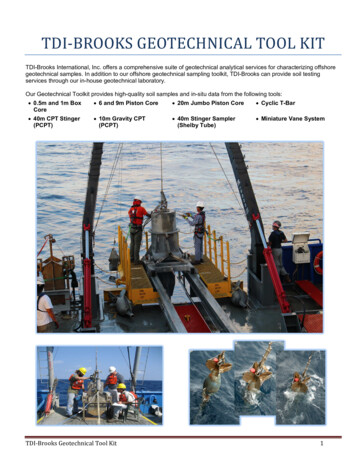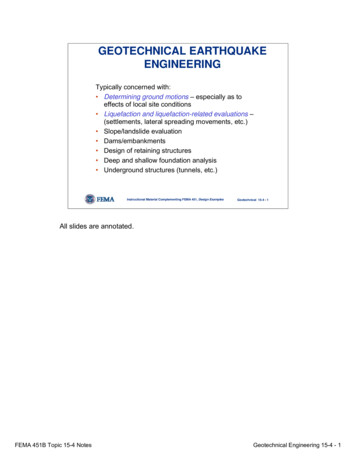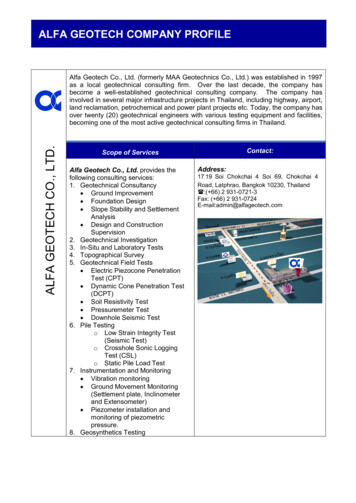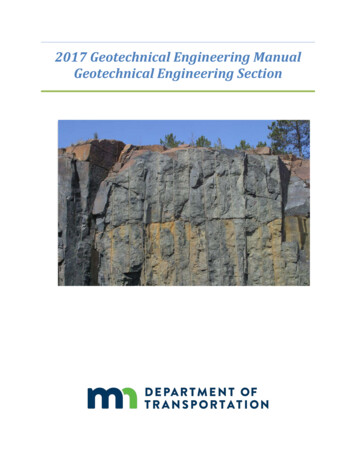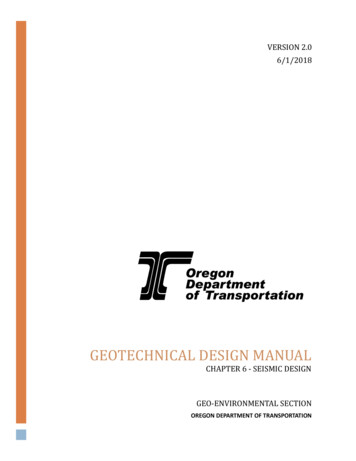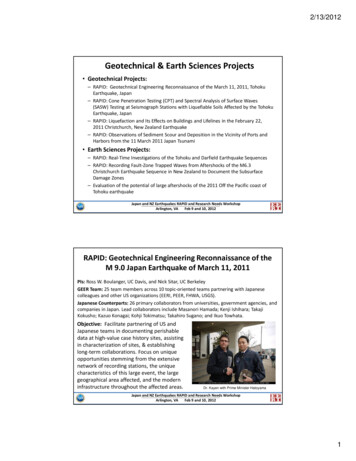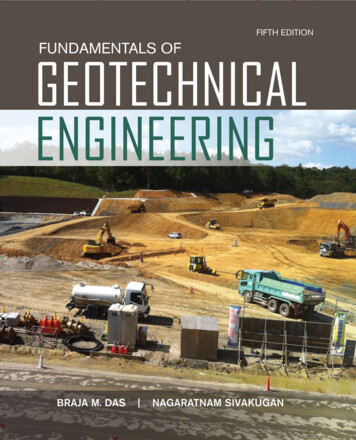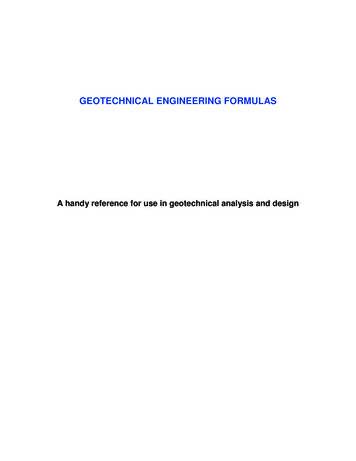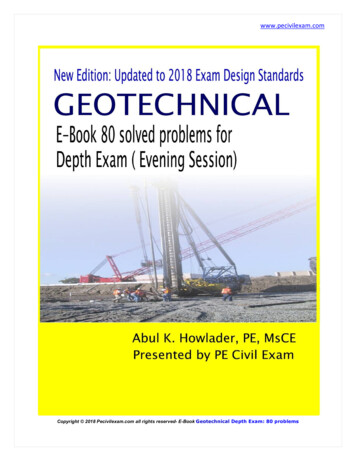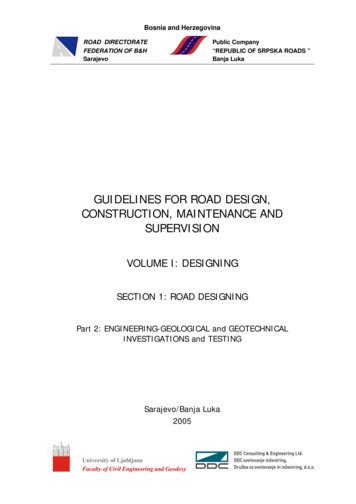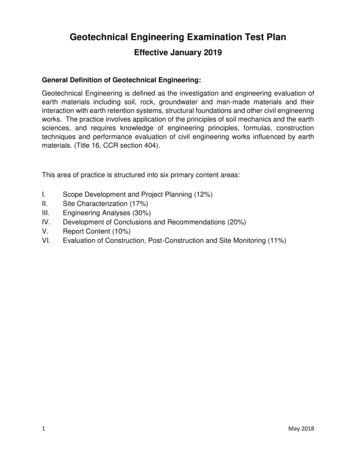
Transcription
Geotechnical Engineering Examination Test PlanEffective January 2019General Definition of Geotechnical Engineering:Geotechnical Engineering is defined as the investigation and engineering evaluation ofearth materials including soil, rock, groundwater and man-made materials and theirinteraction with earth retention systems, structural foundations and other civil engineeringworks. The practice involves application of the principles of soil mechanics and the earthsciences, and requires knowledge of engineering principles, formulas, constructiontechniques and performance evaluation of civil engineering works influenced by earthmaterials. (Title 16, CCR section 404).This area of practice is structured into six primary content areas:I.II.III.IV.V.VI.1Scope Development and Project Planning (12%)Site Characterization (17%)Engineering Analyses (30%)Development of Conclusions and Recommendations (20%)Report Content (10%)Evaluation of Construction, Post-Construction and Site Monitoring (11%)May 2018
BPELSG Geotechnical Engineering Test PlanPercentageof Questionson the ExamI. Scope Development and Project PlanningProfessional Activities:1. Develop project description based on information obtained from the clientand/or design team (e.g., structural loading, location, preliminary project plan)2. Evaluate potential geotechnical and regulatory issues that may influenceinvestigation, design and construction of the proposed project3. Evaluate relevant data about site and subsurface conditions by reviewingavailable regional and site-specific information (e.g., geology, topography,reconnaissance, aerial/satellite photographs)4. Develop proposal, scope of work, or work plan for field exploration, laboratorytesting, analyses, geotechnical recommendations, and construction observation forthe proposed project12%Test questions on these professional activities may include one or more of thefollowing:A. Developing a geotechnical scope of workB. Methodologies to gather, review and interpret available information relevantto site and projectC. The effects of the design team’s criteria (e.g., civil, structural) on thegeotechnical scope of workD. Geotechnical considerations for different project types (e.g., buildings,bridges, tunnels, pipelines, dams)E. Regulatory and code requirementsF. Effects of surface conditions (e.g., topography, existing improvements)G. Effects of geology and geomorphologyH. Effects of local and regional geologic hazards (e.g., earthquakes, landslides,liquefaction)I. Field exploration and instrumentation methodologiesJ. Laboratory tests including their application to site characterization andanalysesK. Analyses relevant to the projectL. Constraints (e.g., environmental, archaeological, biological) that affectgeotechnical scope and/or project planningM. Risk and liability considerationsN. The “standard of care” for geotechnical engineeringO. Impacts of geotechnical scope of work on project schedule and cost2May 2018
II. Site CharacterizationProfessional Activities:1. Identify local and regional geologic hazards (e.g., earthquakes, landslides,liquefaction)2. Conduct a reconnaissance to assess site conditions3. Perform subsurface exploration (e.g., drilling, in-situ tests, CPT, test pits) tocollect soil, rock and groundwater data and prepare field logs of explorations4. Measure groundwater depth/pressure and/or ground movement using fieldinstrumentation (e.g., piezometer, inclinometer, extensometer)5. Review field exploration data for consistency with local geologic information6. Evaluate the need for changes to proposed exploration program during fieldinvestigations7. Develop soil classifications from field investigations and laboratory testing8. Determine engineering properties from results of field investigations andlaboratory testing9. Evaluate the need for changes to laboratory testing program17%Test questions on these professional activities may include one or more of thefollowing:A. Safety regulations pertaining to site explorationB. Regulatory and code requirements for site explorationC. Exploration methods to evaluate subsurface conditionsD. Measures to address constraints that affect geotechnical exploration (e.g.,underground utilities, environmental, archaeological, biological)E. Geophysical methodsF. Where to locate proposed explorations in the fieldG. Sampling techniques and their purposesH. Procedures to log subsurface conditionsI. Visual-manual soil classificationJ. In-situ testing methods (e.g., CPT, SPT, Torvane shear, percolation, infiltration)and factors that influence the validity of the resultK. Different types of field instrumentation and their applicationsL. Factors that may alter the work plan during field investigation (e.g.,unexpected soil strata, refusal, groundwater)M. Site conditions to document during field investigationN. Procedures to follow when suspected hazardous materials are encounteredin site investigationsO. Effects of exploration and sampling methods on laboratory test resultsP. Procedures and interpretation of particle-size distribution testsQ. Procedures and interpretation of Atterberg Limits testR. Procedures and interpretation of density testsS. Procedures and interpretation of water content tests3May 2018
T. Procedures and interpretation of swell/expansion testsU. Procedures and interpretation of collapse testsV. Procedures and interpretation of consolidation testsW. Procedures and interpretation of R-value testsX. Procedures and interpretation of hydraulic conductivity testsY. Procedures and interpretation of compaction testsZ. Procedures and interpretation of unconfined compression testsAA. Procedures and interpretation of direct shear testsBB. Procedures and interpretation of triaxial shear testsCC. Evaluation of soil corrosivityDD. Methods to identify local and regional geologic hazards (e.g., earthquakes,landslides, liquefaction)III. Engineering AnalysesProfessional Activities:1. Develop an idealized soil profile(s) to characterize the engineering properties ofthe subsurface strata by integration of field and laboratory data2. Analyze soil movement (e.g., settlement, expansion, collapse) using availabledata and project requirements3. Analyze lateral earth pressures using available data and project requirements4. Analyze capacity of foundations and ground anchors using available data andproject requirements5. Analyze infiltration rates, groundwater conditions and seepage using availabledata and project requirements6. Analyze slope stability using available data and project requirements7. Analyze impact of seismicity and geologic hazards (e.g., landslides, liquefaction)using available data and project requirements8. Perform pavement design based on available data and project requirements9. Analyze earthwork and grading based on available data and projectrequirements30%Test questions on these professional activities may include one or more of thefollowing:A. Stress distributionB. Immediate/elastic settlement analysesC. Consolidation settlement analysesD. Collapse potentialE. Swell/expansion potentialF. Static lateral earth pressuresG. Seismic lateral earth pressuresH. Retaining wall design (e.g., sliding, overturning, global stability, deflection)I. Capacity of ground anchorsJ. Mechanically stabilized earth (MSE) wall design4May 2018
K. Slope stability and associated deformation (static and seismic)L. Vertical and lateral load capacity and deflections for shallow foundationsM. Axial and lateral load capacity and deflections for deep foundationsN. Design parameters for mat foundationsO. Design parameters for post-tensioned slabsP. Seepage (e.g., flow nets, infiltration, gradient, uplift forces)Q. Construction dewateringR. Filter criteria (e.g., dams, subdrains, dewatering, injection wells)S. Code-related seismic design criteriaT. Earthquake ground motions (site acceleration)U. Site specific response spectraV. Liquefaction evaluationW. Seismically-induced settlementX. Lateral spreadingY. Site earthwork (e.g., bulking, shrinkage)Z. Pavement design (e.g., flexible and rigid structural sections)IV. Development of Conclusions and RecommendationsProfessional Activities:1. Develop recommendations to mitigate soil movement (e.g., settlement,expansion, collapse)2. Develop recommendations for foundations and slabs3. Develop recommendations related to slope stability4. Develop recommendations that incorporate lateral earth pressures5. Develop recommendations related to groundwater and seepage conditions6. Develop recommendations for surface drainage / subsurface infiltration7. Develop recommendations to mitigate seismic hazards8. Develop recommendations for pavement design (e.g., section thickness,subgrade preparation)9. Develop recommendations for earthwork and grading10. Develop recommendations for field instrumentation programs11. Develop a quality assurance program for project construction to determineconformance with recommendations in geotechnical report20%Test questions on these professional activities may include one or more of thefollowing:A. Evaluating feasibility of alternativesB. Effects of regulatory requirements (e.g., OSHA, CBC, CGS) on formulation ofrecommendations and specificationsC. Potential impacts of site recommendations on adjacent propertiesD. Potential discrepancies between field and laboratory dataE. Effects of settlement on proposed improvements (e.g., immediate,consolidation, collapse, seismic)5May 2018
F. Soil expansion impact on proposed improvementsG. Potentially corrosive soilsH. Constructability (e.g., retaining walls, foundations, pipelines)I. Shallow foundations (e.g., capacity, type, size, embedment)J. Deep foundations (e.g., capacity, type, size, depth)K. Exterior slab-on-grade support (non-structural)L. Retention / retaining wall systems (e.g., types, components, applications)M. Pavement recommendations (e.g., structural sections, subgradepreparation/improvement)N. Moisture intrusion mitigationO. Subdrain design (e.g., retaining wall, canyons, french drains)P. Seepage and groundwater impacts and mitigationQ. Static and seismic lateral earth pressuresR. Types and applications of geosynthetics (e.g., subgrade improvement, slopestabilization, MSE, groundwater protection, erosion)S. Seismic design criteria and applicable codesT. Geologic hazards mitigation (e.g., fault rupture, rockfall, tsunami, landslide)U. Site earthwork (e.g., excavatability, compaction requirements,overexcavation, soil suitability)V. Temporary excavation and shoringW. Impacts of construction proceduresX. Techniques and applications for ground improvement or modification andtheir advantages and limitationsY. Slope stabilization alternativesZ. Field instrumentation and monitoring programsAA. Liquefaction mitigationBB. Lateral spreading mitigationCC. Factors of safety and resistance factors (LRFD) for incorporation into designrecommendationsDD. Quality assurance program6May 2018
V. Report ContentProfessional Activities:1. Describe project scope and purpose of work in a formal written report2. Describe findings of document review, reconnaissance, field exploration,laboratory testing, and analyses in a formal written report3. Describe methodologies used in field exploration, lab testing and analyses in aformal written report4. Describe conclusions, recommendations, and limitations based on geotechnicalfindings in a formal written report5. Prepare and summarize supporting data (e.g., site plan, logs of field exploration,soil profiles/cross-sections, laboratory test data, references, guidelinespecifications) in a formal written report10%Test questions on these professional activities may include one or more of thefollowing:A. Components of geotechnical investigation reportsB. Elements of field and laboratory documentationC. Current applicable referencesD. Limitations of the geotechnical investigation and recommendationsE. Components of geotechnical guideline specificationsVI. Evaluation of Construction, Post-Construction and SiteMonitoringProfessional Activities:1. Review plans, specifications, and construction documentation (e.g., submittalsand request for information) for conformance with geotechnical recommendations2. Observe and test during construction activities to evaluate conformance withgeotechnical aspects of plans and specifications3. Evaluate the need for revised recommendations based on changed conditions4. Evaluate site conditions by installing, monitoring, and evaluating results of fieldinstrumentation5. Document results of construction monitoring and post construction observations11%Test questions on these professional activities may include one or more of thefollowing:A. Factors to consider when reviewing plans and specifications for geotechnicalissuesB. Methods to verify that project construction conforms to geotechnicalrecommendations, plans and specifications7May 2018
C. Required observation and monitoring elements to document during and afterconstructionD. Effects of regulatory requirements, including health and safety regulations,during constructionE. Interpretation of data from observations, testing, and field instrumentationbefore, during and after constructionF. Techniques to mitigate differing site conditions encountered duringconstructionG. Forensic/failure evaluations and techniques8May 2018
A. Developing a geotechnical scope of work B. Methodologies to gather, review and interpret available information relevant to site and project C. The effects of the design team's criteria (e.g., civil, structural) on the geotechnical scope of work D. Geotechnical considerations for different project types (e.g., buildings,
